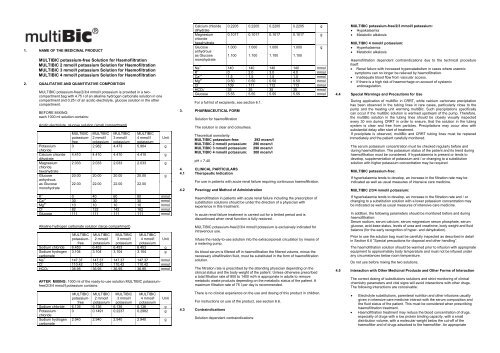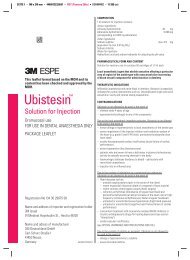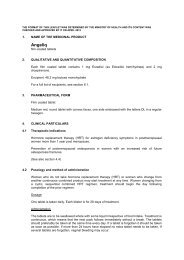MULTIBIC potassium-free Solution for Haemofiltration MULTIBIC 2 ...
MULTIBIC potassium-free Solution for Haemofiltration MULTIBIC 2 ...
MULTIBIC potassium-free Solution for Haemofiltration MULTIBIC 2 ...
You also want an ePaper? Increase the reach of your titles
YUMPU automatically turns print PDFs into web optimized ePapers that Google loves.
1. NAME OF THE MEDICINAL PRODUCT<br />
<strong>MULTIBIC</strong> <strong>potassium</strong>-<strong>free</strong> <strong>Solution</strong> <strong>for</strong> <strong>Haemofiltration</strong><br />
<strong>MULTIBIC</strong> 2 mmol/l <strong>potassium</strong> <strong>Solution</strong> <strong>for</strong> <strong>Haemofiltration</strong><br />
<strong>MULTIBIC</strong> 3 mmol/l <strong>potassium</strong> <strong>Solution</strong> <strong>for</strong> <strong>Haemofiltration</strong><br />
<strong>MULTIBIC</strong> 4 mmol/l <strong>potassium</strong> <strong>Solution</strong> <strong>for</strong> <strong>Haemofiltration</strong><br />
2. QUALITATIVE AND QUANTITATIVE COMPOSITION<br />
<strong>MULTIBIC</strong> <strong>potassium</strong>-<strong>free</strong>/2/3/4 mmol/l <strong>potassium</strong> is provided in a twocompartment<br />
bag with 4.75 l of an alkaline hydrogen carbonate solution in one<br />
compartment and 0.25 l of an acidic electrolyte, glucose solution in the other<br />
compartment.<br />
BEFORE MIXING:<br />
each 1000 ml solution contains:<br />
Acidic electrolyte, glucose solution (small compartment)<br />
Potassium<br />
chloride<br />
Calcium chloride<br />
dihydrate<br />
Magnesium<br />
chloride<br />
hexahydrate<br />
Glucose<br />
anhydrous<br />
as Glucose<br />
monohydrate<br />
<strong>MULTIBIC</strong> <strong>MULTIBIC</strong> <strong>MULTIBIC</strong> <strong>MULTIBIC</strong><br />
<strong>potassium</strong>- 2 mmol/l 3 mmol/l 4 mmol/l Unit<br />
<strong>free</strong> <strong>potassium</strong> <strong>potassium</strong> <strong>potassium</strong><br />
0 2.982 4.473 5.964 g<br />
4.410 4.410 4.410 g 4.410 g<br />
2.033 2.033 2.033 2.033 g<br />
20.00 20.00 20.00 20.00 g<br />
22.00 22.00 22.00 22.00<br />
K + 0 40 60 80 mmol<br />
Ca 2+ 30 30 30 30 mmol<br />
Mg 2+ 10 10 10 10 mmol<br />
Cl - 82 122 142 162 mmol<br />
Glucose 111 111 111 111 mmol<br />
Alkaline hydrogen carbonate solution (large compartment)<br />
<strong>MULTIBIC</strong><br />
<strong>potassium</strong><strong>free</strong><br />
<strong>MULTIBIC</strong><br />
2 mmol/l<br />
<strong>potassium</strong><br />
<strong>MULTIBIC</strong><br />
3 mmol/l<br />
<strong>potassium</strong><br />
<strong>MULTIBIC</strong><br />
4 mmol/l<br />
<strong>potassium</strong><br />
Sodium chloride 6.453 6.453 6.453 6.453 g<br />
Sodium hydrogen<br />
carbonate<br />
3.104 3.104 3.104 3.104 g<br />
Na + 147.37 147.37 147.37 147.37 mmol<br />
Cl - 110.42 110.42 110.42 110.42 mmol<br />
HCO3 - 36.95 36.95 36.95 36.95 mmol<br />
AFTER MIXING: 1000 ml of the ready-to-use solution <strong>MULTIBIC</strong> <strong>potassium</strong><strong>free</strong>/2/3/4<br />
mmol/l <strong>potassium</strong> contains:<br />
<strong>MULTIBIC</strong><br />
<strong>potassium</strong><strong>free</strong><br />
<strong>MULTIBIC</strong><br />
2 mmol/l<br />
<strong>potassium</strong><br />
<strong>MULTIBIC</strong><br />
3 mmol/l<br />
<strong>potassium</strong><br />
<strong>MULTIBIC</strong><br />
4 mmol/l<br />
<strong>potassium</strong><br />
Sodium chloride 6.136 6.136 6.136 6.136 g<br />
Potassium<br />
chloride<br />
0 0.1491 0.2237 0.2982 g<br />
Sodium hydrogen<br />
carbonate<br />
2.940 2.940 2.940 2.940 g<br />
Unit<br />
Unit<br />
Calcium chloride<br />
dihydrate<br />
Magnesium<br />
chloride<br />
hexahydrate<br />
Glucose<br />
anhydrous<br />
as Glucose<br />
monohydrate<br />
Na +<br />
0.2205 0.2205 0.2205 0.2205 g 0.2205 g <strong>MULTIBIC</strong> 0.2205 <strong>potassium</strong>-<strong>free</strong>/2/3 g 0.2205 g mmol/l <strong>potassium</strong>:<br />
� Hypokalaemia<br />
0.1017 0.1017 0.1017 0.1017 g<br />
� Metabolic alkalosis<br />
1.000 1.000 1.000 1.000 g<br />
1.100<br />
1.100 1.100 1.100<br />
140 140 140 140 mmol<br />
K + 0 2.0 3.0 4.0 mmol<br />
Ca 2+ 1.5 1.5 1.5 1.5 mmol<br />
Mg 2+ 0.50 0.50 0.50 0.50 mmol<br />
Cl - 109 111 112 113 mmol<br />
HCO3 - 35 35 35 35 mmol<br />
Glucose 5.55 5.55 5.55 5.55 mmol<br />
For a full list of excipients, see section 6.1.<br />
3. PHARMACEUTICAL FORM<br />
<strong>Solution</strong> <strong>for</strong> haemofiltration<br />
The solution is clear and colourless.<br />
Theoretical osmolarity:<br />
<strong>MULTIBIC</strong> <strong>potassium</strong>-<strong>free</strong>: 292 mosm/l<br />
<strong>MULTIBIC</strong> 2 mmol/l <strong>potassium</strong>: 296 mosm/l<br />
<strong>MULTIBIC</strong> 3 mmol/l <strong>potassium</strong>: 298 mosm/l<br />
<strong>MULTIBIC</strong> 4 mmol/l <strong>potassium</strong>: 300 mosm/l<br />
pH � 7.40<br />
4. CLINICAL PARTICULARS<br />
4.1 Therapeutic Indication<br />
For use in patients with acute renal failure requiring continuous haemofiltration.<br />
4.2 Posology and Method of Administration<br />
<strong>Haemofiltration</strong> in patients with acute renal failure including the prescription of<br />
substitution solutions should be under the direction of a physician with<br />
experience in this treatment.<br />
In acute renal failure treatment is carried out <strong>for</strong> a limited period and is<br />
discontinued when renal function is fully restored.<br />
<strong>MULTIBIC</strong> <strong>potassium</strong>-<strong>free</strong>/2/3/4 mmol/l <strong>potassium</strong> is exclusively indicated <strong>for</strong><br />
intravenous use.<br />
Infuse the ready-to-use solution into the extracorporeal circulation by means of<br />
a metering pump.<br />
As blood serum is filtered off in haemofiltration the filtered volume, minus the<br />
necessary ultrafiltration fluid, must be substituted in the <strong>for</strong>m of haemofiltration<br />
solution.<br />
The filtration rate is prescribed by the attending physician depending on the<br />
clinical status and the body weight of the patient. Unless otherwise prescribed<br />
a total filtration rate of 800 to 1400 ml/h is appropriate in adults to remove<br />
metabolic waste products depending on the metabolic status of the patient. A<br />
maximum filtration rate of 75 l per day is recommended.<br />
There is no clinical experience on the use and dosing of this product in children.<br />
For instructions on use of the product, see section 6.6.<br />
4.3 Contraindications<br />
<strong>Solution</strong> dependent contraindications:<br />
<strong>MULTIBIC</strong> 4 mmol/l <strong>potassium</strong>:<br />
� Hyperkalaemia<br />
� Metabolic alkalosis<br />
<strong>Haemofiltration</strong> dependent contraindications due to the technical procedure<br />
itself:<br />
� Renal failure with increased hypercatabolism in cases where uraemic<br />
symptoms can no longer be relieved by haemofiltration.<br />
� Inadequate blood flow from vascular access.<br />
� If there is a high risk of haemorrhage on account of systemic<br />
anticoagulation.<br />
4.4 Special Warnings and Precautions <strong>for</strong> Use<br />
During application of multiBic in CRRT, white calcium carbonate precipitation<br />
has been observed in the tubing lines in rare cases, particularly close to the<br />
pump and the heating unit warming multiBic. Such precipitations specifically<br />
can occur if the multiBic solution is warmed upstream of the pump. There<strong>for</strong>e,<br />
the multiBic solution in the tubing lines should be closely visually inspected<br />
every 30 min during CRRT in order to ensure, that the solution in the tubing<br />
system is clear and <strong>free</strong> from particles. Precipitations may occur also with<br />
substantial delay after start of treatment.<br />
If precipitate is observed, multiBic and CRRT tubing lines must be replaced<br />
immediately and the patient carefully monitored.<br />
The serum <strong>potassium</strong> concentration must be checked regularly be<strong>for</strong>e and<br />
during haemofiltration. The <strong>potassium</strong> status of the patient and its trend during<br />
haemofiltration must be considered. If hypokalaemia is present or tends to<br />
develop, supplementation of <strong>potassium</strong> and / or changing to a substitution<br />
solution with higher <strong>potassium</strong> concentration may be required.<br />
<strong>MULTIBIC</strong> <strong>potassium</strong>-<strong>free</strong>:<br />
If hyperkalaemia tends to develop, an increase in the filtration rate may be<br />
indicated as well as usual measures of intensive care medicine.<br />
<strong>MULTIBIC</strong> 2/3/4 mmol/l <strong>potassium</strong>:<br />
If hyperkalaemia tends to develop, an increase in the filtration rate and / or<br />
changing to a substitution solution with a lower <strong>potassium</strong> concentration may<br />
be indicated as well as usual measures of intensive care medicine.<br />
In addition, the following parameters should be monitored be<strong>for</strong>e and during<br />
haemofiltration:<br />
Serum sodium, serum calcium, serum magnesium serum phosphate, serum<br />
glucose, acid-base status, levels of urea and creatinine, body weight and fluid<br />
balance (<strong>for</strong> the early recognition of hyper- and dehydration).<br />
Prior to use the solution bag must be carefully inspected as described in detail<br />
in Section 6.6 “Special precautions <strong>for</strong> disposal and other handling”.<br />
The haemofiltration solution should be warmed prior to infusion with appropriate<br />
equipment to approximately body temperature and must not be infused under<br />
any circumstances below room temperature.<br />
Do not use be<strong>for</strong>e mixing the two solutions.<br />
4.5 Interaction with Other Medicinal Products and Other Forms of Interaction<br />
The correct dosing of substitutions solutions and strict monitoring of clinical<br />
chemistry parameters and vital signs will avoid interactions with other drugs.<br />
The following interactions are conceivable:<br />
� Electrolyte substitutions, parenteral nutrition and other infusions usually<br />
given in intensive care medicine interact with the serum composition and<br />
the fluid status of the patient. This must be considered when prescribing<br />
haemofiltration treatment.<br />
� <strong>Haemofiltration</strong> treatment may reduce the blood concentration of drugs,<br />
especially of drugs with a low protein binding capacity, with a small<br />
distribution volume, with a molecular weight below the cut-off of the<br />
haemofilter and of drugs adsorbed to the haemofilter. An appropriate
evision of the dose of such drugs may be required.<br />
� Toxic effects of digitalis may be masked by hyperkalaemia,<br />
hypermagnesaemia and hypocalcaemia. The correction of these<br />
electrolytes by haemofiltration may precipitate signs and symptoms of<br />
digitalis toxicity, e.g. cardiac arrhythmia.<br />
4.6 Fertility,Pregnancy and Lactation<br />
At present no clinical experience is available. The bicarbonate-buffered<br />
substitution solution must only be used after assessment of the potential risks<br />
and benefits <strong>for</strong> the mother and child.<br />
4.7 Effects on Ability to Drive and Use Machines<br />
Not relevant.<br />
4.8 Undesirable Effects<br />
Adverse reactions, such as nausea, vomiting, muscle cramps, hypotension and<br />
hypertension, may result from the treatment mode itself or may be induced by<br />
the substitution solution.<br />
In general, the tolerability of bicarbonate buffered haemofiltration solution is<br />
good. However, the following potential side effects of the treatment can be<br />
anticipated:<br />
Hyper- or hypohydration, electrolyte disturbances (e.g., hypokalaemia),<br />
hypophosphataemia, hyperglycaemia, and metabolic alkalosis.<br />
4.9 Overdose<br />
After use of recommended doses no reports of emergency situations have<br />
arisen; moreover, the administration of the solution can be discontinued at any<br />
time. If fluid balance is not accurately calculated and monitored, hyperhydration<br />
or dehydration may occur, with the resultant associated circulatory reactions.<br />
These may be manifest through changes in blood pressure, central venous<br />
pressure, heart rate, and pulmonary arterial pressure. In cases of<br />
hyperhydration congestive cardiac failure and/or pulmonary congestion may be<br />
induced.<br />
In cases of hyperhydration, ultrafiltration should be increased, and the rate and<br />
volume of substitution solution infused reduced. In cases of marked<br />
dehydration, ultrafiltration should be decreased or discontinued, and the volume<br />
of substitution solution infused increased as appropriate.<br />
Over treatment may result in disturbances of electrolyte concentrations and the<br />
acid-base-balance, e. g. an overdose of bicarbonate may occur if an<br />
inappropriate large volume of substitution solution is infused/administered. This<br />
could possibly lead to metabolic alkalosis, decrease of ionized calcium, or<br />
tetany.<br />
5. PHARMACOLOGICAL PROPERTIES<br />
5.1 Pharmacodynamic Properties<br />
Pharmacotherapeutic group<br />
Group: <strong>Solution</strong> <strong>for</strong> haemofiltration<br />
ATC code: B05Z B - Haemofiltrates<br />
Basic principles of <strong>Haemofiltration</strong>:<br />
During continuous haemofiltration water and solutes such as uremic toxins,<br />
electrolytes, and bicarbonate are removed from the blood by ultrafiltration. The<br />
ultrafiltrate is replaced by a substitution solution (a solution <strong>for</strong> haemofiltration),<br />
with a balanced electrolyte and buffer composition.<br />
The ready-to-use haemofiltration solution is a bicarbonate-buffered substitution<br />
solution <strong>for</strong> intravenous administration <strong>for</strong> the treatment of acute renal failure of<br />
any origin by continuous haemofiltration.<br />
The electrolytes Na + , K + , Mg 2+ , Ca 2+ , Cl - , and bicarbonate are essential <strong>for</strong> the<br />
maintenance and correction of fluids and electrolyte homeostasis (blood<br />
volume, osmotic equilibrium, acid-base balance).<br />
5.2 Pharmacokinetic Properties<br />
The ready-to-use haemofiltration solution must only be administered<br />
intravenously.<br />
The distribution of electrolytes and bicarbonate is regulated in accordance with<br />
requirements and the metabolic status and residual renal function. The active<br />
substances of the substitution solution are not metabolized except <strong>for</strong> glucose.<br />
The elimination of water and electrolytes depends on cellular requirements, the<br />
metabolic status, the residual renal function, and on other routes of fluid losses<br />
(e.g., gut, lung, and skin).<br />
5.3 Preclinical Safety Data<br />
There are no preclinical data of relevance to the prescriber.<br />
6. PHARMACEUTICAL PARTICULARS<br />
6.1 List of Excipients<br />
in small compartment A:<br />
Water <strong>for</strong> injections<br />
Hydrochloric acid 25%<br />
in large compartment B:<br />
Water <strong>for</strong> injections<br />
Carbon dioxide<br />
6.2 Incompatibilities<br />
In the absence of compatibility studies, this medicinal product must not be<br />
mixed with other medicinal products. If an addition to the substitution solution is<br />
done, it should be done only after evaluating the compatibility with the<br />
substitution solution and only after the two compartments of the substitution<br />
solution have been thoroughly mixed.<br />
6.3 Shelf Life<br />
Shelf life<br />
of the medicinal product packaged <strong>for</strong> sale 2 years<br />
Shelf life after opening of the container: -<br />
Shelf life after mixing: 48 hours<br />
Chemical and physical in-use stability of the ready-to-use solution has been<br />
demonstrated <strong>for</strong> 48 hours at 25°C.<br />
From a microbiological point of view, once connected to the haemofiltration<br />
circuit, the product shall be used immediately. Other in-use storage times<br />
and conditions (longer than 48 hours, higher than 25°C) are the<br />
responsibility of the user.<br />
6.4 Special Precautions <strong>for</strong> Storage<br />
Do not store below +4°C<br />
6.5 Nature and Contents of Container<br />
Double chamber bag:<br />
4.75 l (alkaline hydrogen carbonate solution) + 0.25 l (acidic electrolyte,<br />
glucose solution) = 5.0 l (ready-to-use solution)<br />
The film used <strong>for</strong> the bag is made of polyethylene terephthalate, which is<br />
coated with SiOx as a gas barrier, polyamide and a polypropylene-synthetic<br />
elastomer blend.<br />
Overwrapping:<br />
The double chamber bag is wrapped into a film made of a polyolefine-synthetic<br />
elastomer and/or plastomer blend.<br />
2 bags of 5000 ml (carton)<br />
6.6 Special precautions <strong>for</strong> disposal and other handling<br />
The haemofiltration solution should be administered in the following steps:<br />
1. Removal of the overwrapping and careful inspection of the haemofiltration<br />
bag<br />
The overwrap should only be removed immediately be<strong>for</strong>e administration.<br />
Plastic containers may occasionally be damaged during transport from the<br />
manufacturer to the dialysis clinic or within the clinic itself. This can lead to<br />
contamination and microbiological or fungal growth in the haemofiltration<br />
solution. Careful visual inspection of the container be<strong>for</strong>e connection and<br />
of the solution be<strong>for</strong>e use is there<strong>for</strong>e necessary. Particular attention<br />
should be paid to even the slightest damage to the closure, the welded<br />
seam and the corners of the container in view of a possible contamination.<br />
The solution should only be used if clear and colourless and if the<br />
container and connectors are undamaged and intact.<br />
In case of doubt, the treating physician should decide about the use of the<br />
haemofiltration solution.<br />
2. Mixing of the two compartments<br />
The two-compartment-bag - the bicarbonate and the electrolytes including<br />
glucose compartments - are mixed immediately be<strong>for</strong>e use to obtain a<br />
solution ready-<strong>for</strong>-use. The mixed solution is clear and colourless.<br />
After mixing both compartments, it must be checked, that the peel seam is<br />
completely open, that the solution is clear and colourless and that the<br />
container is not leaking.<br />
A)<br />
B)<br />
C)<br />
3. Ready-to-use solution<br />
Unfold the small compartment.<br />
Roll up the solution bag starting from<br />
the corner opposite the small<br />
compartment ...<br />
Any addition to the substitution solution should only be done after the<br />
substitution solution has been thoroughly mixed (see also 6.2). After such<br />
an addition, the substitution solution should again be thoroughly mixed<br />
prior to the start of the infusion.<br />
The ready-to-use solution should be used immediately, but within a<br />
maximum of 48 hours after mixing.<br />
If not otherwise prescribed, the ready-to-use substitution solution should<br />
be warmed immediately be<strong>for</strong>e infusion to 36.5 °C – 38.0 °C. The exact<br />
temperature must be selected depending on clinical requirements and the<br />
technical equipment used.<br />
The haemofiltration solution is <strong>for</strong> single use.<br />
… until the peel seam between both<br />
compartments has opened along its entire<br />
length and the solutions from both<br />
compartments are mixed.<br />
Partially used and damaged containers should be discarded.<br />
7. MANUFACTURER : Fresenius Medical Care Deutschland GmbH,61346 Bad<br />
Homburg v.d.H Germany<br />
8. REGISTRATION HOLDER: Cure Medical and Technical Supply Ltd, 4<br />
Baltimore st., Petach Tiqva.<br />
The content of this leaflet has been determined by the Israeli MOH and has been<br />
checked and approved –February 2011<br />
SH Z7011019999B/MUL FEB11
















